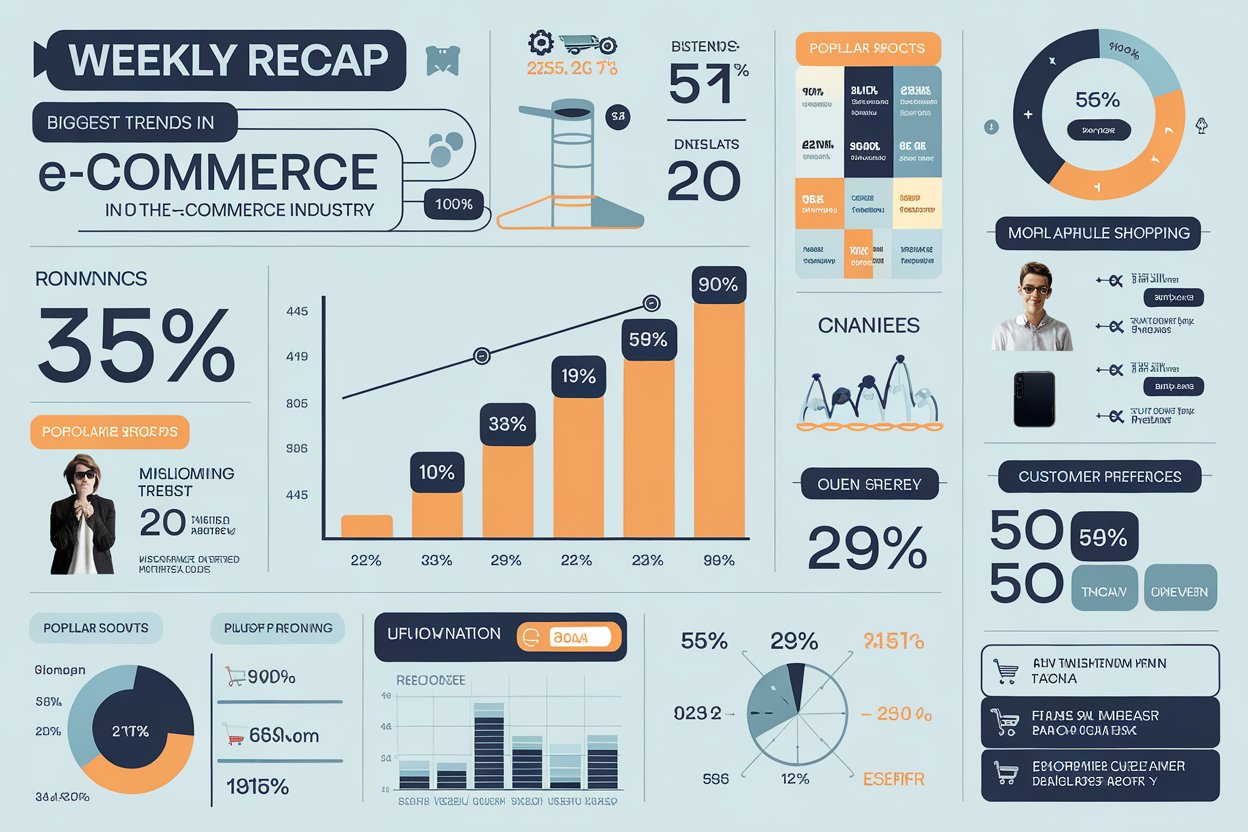Weekly Recap: Biggest Trends in the E-commerce Industry (Dec 2024)
E-commerce is an ever-evolving industry, and staying updated on the latest trends is crucial for entrepreneurs, businesses, and marketers. December 2024 has been a pivotal month for e-commerce, marked by significant technological advancements, consumer behavior shifts, and innovative strategies. Here's a comprehensive weekly recap of the biggest trends shaping the e-commerce landscape this month.
1. Rise of AI-Powered Personalization
Artificial intelligence (AI) continues to revolutionize e-commerce by offering hyper-personalized shopping experiences. Platforms are using AI to analyze consumer behavior and deliver tailored product recommendations, personalized email marketing, and dynamic pricing strategies.
Key Highlights:
- AI chatbots and virtual shopping assistants are enhancing customer support.
- Real-time personalization is driving higher conversion rates.
Related Resources:
- Course: Artificial Intelligence in E-commerce by Coursera
- Blog: AI Trends in Retail on Smart Insights
- Tool: Dynamic Yield, an AI-powered personalization platform.
2. Surge in Social Commerce
Social media platforms like Instagram, TikTok, and Facebook are becoming powerful e-commerce hubs. This trend, known as social commerce, allows users to discover, browse, and purchase products directly through social media apps.
Key Highlights:
- Instagram and TikTok now offer enhanced in-app shopping features.
- Influencer marketing campaigns are seamlessly integrated with shoppable posts.
Related Resources:
- Course: Social Media Marketing Mastery on Udemy
- YouTube Channel: Neil Patel's Social Media Strategies
- Tool: Hootsuite for managing social media campaigns.
3. Green Consumerism and Sustainable Practices
Eco-conscious shopping continues to gain traction as consumers prioritize sustainability. E-commerce brands are adopting environmentally friendly practices, such as reducing packaging waste and offering carbon-neutral shipping options.
Key Highlights:
- Growing demand for sustainable products and ethical sourcing.
- Certifications like FSC and Fair Trade are becoming key selling points.
Related Resources:
- Book: Green to Gold by Daniel C. Esty and Andrew S. Winston.
- Blog: Sustainable E-commerce Trends on The Good Trade
- Tool: Ecosia, a search engine that plants trees for every search.
4. Omnichannel Retail Expansion
The line between online and offline shopping continues to blur as more brands adopt omnichannel strategies. Retailers are integrating their physical stores with e-commerce platforms to provide a seamless customer experience.
Key Highlights:
- Buy Online, Pick Up in Store (BOPIS) services are increasing in popularity.
- Virtual and augmented reality are being used to enhance the in-store shopping experience.
Related Resources:
- Course: Omnichannel Marketing Strategy by LinkedIn Learning
- YouTube Channel: HubSpot’s Omnichannel Marketing Tips
- Tool: Shopify POS, a point-of-sale system for omnichannel retailing.
5. Growth of Subscription-Based Models
Subscription models are becoming a staple in e-commerce, offering businesses predictable revenue streams while fostering customer loyalty. Consumers appreciate the convenience of automatic deliveries for products like groceries, skincare, and fitness gear.
Key Highlights:
- Subscription boxes are gaining popularity across diverse niches.
- Brands are using AI to recommend subscription plans based on user preferences.
Related Resources:
- Course: Launching a Subscription-Based Business by Teachable
- Blog: Subscription Trends on Subbly Blog
- Tool: ReCharge Payments, a platform for managing subscriptions.
6. Dominance of Voice Commerce
With the increasing adoption of voice assistants like Amazon Alexa, Google Assistant, and Siri, voice commerce is shaping the way consumers shop online. Voice search is being used for everything from product discovery to order placement.
Key Highlights:
- Voice search optimization is becoming crucial for e-commerce websites.
- Smart speakers are driving this trend by making voice shopping accessible.
Related Resources:
- Book: Voice Strategy by Daniel Hill.
- Blog: Voice Commerce Trends on BigCommerce
- Tool: Jetson AI, a platform for voice commerce.
7. Expansion of Cross-Border E-commerce
Global e-commerce is on the rise, with more consumers shopping from international brands. Advancements in logistics and payment processing are making it easier for e-commerce businesses to sell globally.
Key Highlights:
- Emerging markets like India, Brazil, and Southeast Asia are experiencing rapid e-commerce growth.
- Currency conversion tools and multi-language support are becoming essential.
Related Resources:
- Course: Global E-commerce Mastery by edX
- YouTube Channel: The E-commerce Mastermind
- Tool: Easyship, a cross-border shipping platform.
Final Thoughts,
The e-commerce industry continues to evolve, and staying informed about these trends is essential for success. By leveraging the tools, resources, and professional expertise highlighted above, you can stay ahead of the curve and grow your e-commerce business effectively. Whether it’s adopting AI-powered personalization, exploring social commerce, or tapping into subscription-based models, the opportunities are endless.
Stay tuned for next week’s recap as we uncover more insights to keep you at the forefront of e-commerce innovation!
Privacy Policy,
Our Privacy Policy outlines how we collect, use, and protect your personal information. We are committed to safeguarding your privacy and ensuring your data remains secure when you visit our site.
Stay informed about how we handle your information.
Terms and Conditions,
The Terms and Conditions detail the rules and regulations for using our website. Please read carefully to understand your responsibilities when accessing our content or services.
Know your rights and obligations as a user.
Affiliate Disclosure,
This Affiliate Disclosure explains how we earn commissions from affiliate links, such as those from Amazon. Any purchase made through our links helps support our website at no extra cost to you.
Transparency is key – see how we earn through recommendations.
Disclaimer,
Our Disclaimer page clarifies that the information provided on this blog is for informational purposes only. We do not provide financial or legal advice, and users should consult professionals for specific issues.
Understand the limitations of the content on our site.
Contact Us,
For any inquiries, feedback, or partnership opportunities, feel free to reach out to us via the Contact Us page. We’re always here to help or address any questions you might have.
Get in touch with us easily for support or collaboration.




Comments
Post a Comment